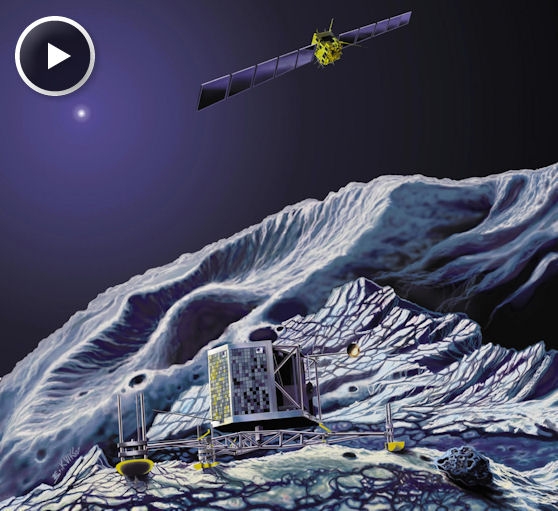Feb. 2, 2012:Europe’s Rosetta spacecraft is en route to intercept a comet– and to make history. In 2014, Rosetta will enter orbit around comet 67P/Churyumov-Gerasimenkoand land a probe on it, two firsts.
Rosetta’s goal is to learn the primordial story a comet tells as it gloriously falls to pieces.
Comets are primitive leftovers from our solar system's 'construction' about 4.5 billion years ago. Because they spend much of their time in the deep freeze of the outer solar system, comets are well preserved—a gold mine for astronomers who want to know what conditions were like back “in the beginning.”
As their elongated orbits swing them closer to the sun, comets transform into the most breathtaking bodies in the night sky. A European Space Agency mission launched in 2004 with U.S. instruments on board, Rosetta will have a front-row seat for the metamorphosis.

An artist's concept of Rosetta in orbit while the mission's lander explores the comet's surface.
What we know of comets so far comes from a handful of flyby missions.
"In some ways, a flyby is just a tantalizing glimpse of a comet at one stage in its evolution," says Claudia Alexander, project scientist for the U.S. Rosetta Project at JPL. "Rosetta is different. It will orbit 67P for 17 months. We'll see this cometevolveright before our eyesas we accompany it toward the sun and back out again."
Fierce solar heat will have a profound effect on Rosetta’s target. "We'll watch the comet start as just a little nugget in space and then become something poetic and beautiful, trailing a vast tail."
At the moment, Rosetta is "resting up" for the challenges ahead. It's hibernating, engaged in its high-speed chase while fast asleep.
Reveille is on or around New Year's Day 2014, when the spacecraft begins a months-long program of self-checkups.
If all goes well, in August of the same year, Rosetta will enter orbit around 67P's nucleus and begin scanning its surface for a landing site. Once a site is chosen, the spacecraft will descend as low as 1 km to deploy the lander.
The lander’s name is “Philae” after an island in the Nile, the site of an obelisk that helped decipher—you guessed it—the Rosetta Stone.
Touchdown is scheduled for November 2014, when Philae will make the first ever controlled landing on a comet's nucleus.
"When we land, the comet could already be active!" says Alexander. Because a comet has little gravity, the lander will anchor itself with harpoons. “The feet may drill into something crunchy like permafrost, or maybe into something rock solid,” she speculates.
Once it is fastened, the lander will commence an unprecedented first-hand study of a comet’s nucleus. Among other things, it will gather samples for examination by automatic onboard microscopes and take panoramic images of the comet’s terrain from ground level.
Meanwhile, orbiting overhead, the Rosetta spacecraft will be busy, too. Onboardsensors will map the comet’s surface and magnetic field, monitor the comet’s erupting jets and geysers, measure outflow rates, and much more. Together, the orbiter and lander will build up the first 3D picture of the layers and pockets under the surface of a comet.
The results should tell quite a story indeed.
